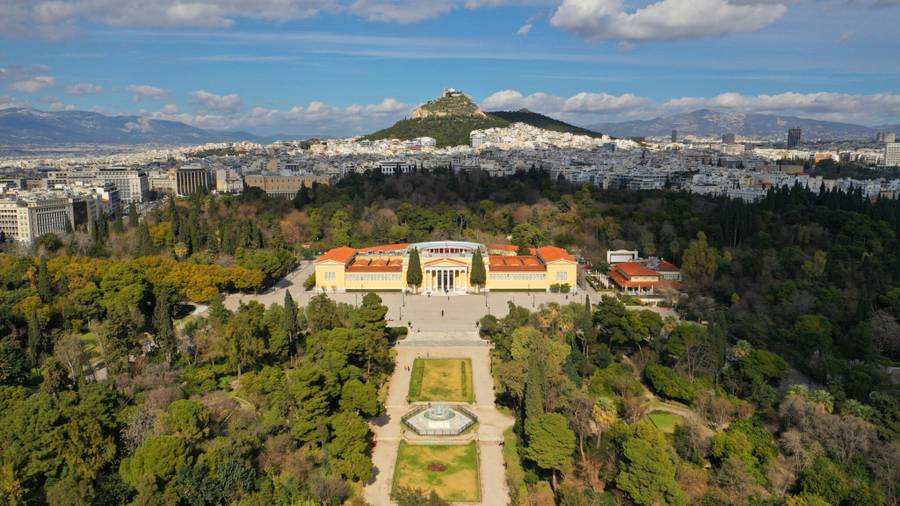Discover the Hidden Green Gems of Athens: A Guide to the City's Most Beautiful Gardens and Parks

Athens, known for its ancient ruins and vibrant culture, is also home to some of the most enchanting gardens and parks. Beyond the iconic Acropolis and bustling city streets, lies a world of lush greenery and tranquil spaces that offer a refreshing escape. Whether you're a nature lover, history enthusiast, or simply looking for a peaceful retreat in the heart of the city, Athens' gardens have something for everyone. In this guide, we’ll take you on a tour of the must-visit gardens in central Athens, including the historic National Garden, the serene Garden of the Byzantine Museum, the elegant Garden of the Presidential Mansion, and the tranquil Japanese Garden. Discover the natural beauty and cultural richness that these hidden green gems have to offer.
1. National Garden and Zappeion Gardens
National Garden:
The National Garden of Athens is a lush, expansive oasis in the heart of the city, covering about 15.5 hectares. It is located directly behind the Greek Parliament building on Syntagma Square. Commissioned by Queen Amalia in 1838 and officially opened in 1840, this garden offers a unique blend of natural beauty and historical significance. It's a place where visitors can escape the bustling city streets and immerse themselves in a world of tranquility and greenery.
One of the garden's most remarkable features is its diverse collection of plants. It is home to over 500 species, some of which were imported from various parts of the world during the garden's early years. These include towering palm trees, which create an exotic atmosphere, as well as a variety of other trees and shrubs that provide ample shade and a cool respite, especially during the hot summer months in Athens. Among the greenery, you'll also find a multitude of colorful flowers that bloom throughout the year, adding a vibrant touch to the landscape.
The National Garden is not just about flora; it also houses several historical and cultural elements. Scattered throughout the garden are ancient ruins and artifacts, including Corinthian columns and mosaics, which give visitors a sense of the rich history that permeates Athens. There's also a small zoo within the garden that features animals like goats, peacocks, and ducks, making it a delightful stop for families with children. A charming duck pond adds to the serene environment, offering a picturesque spot for relaxation.
In addition to these natural and historical features, the National Garden boasts a botanical museum and a small café where visitors can enjoy a coffee or a light snack amidst the greenery. The garden is crisscrossed with winding paths that lead to hidden corners and shaded benches, perfect for a leisurely stroll or a moment of reflection.
For those interested in botany, the garden's diverse plant life provides a unique opportunity to learn about different species and their origins.
Address: National Garden: Leoforos Vasilissis Amalias 1, Athens 105 57, Greece.
Zappeion Gardens:
Adjacent to the National Garden, the Zappeion Gardens surround the neoclassical Zappeion Hall, an iconic building that has played a significant role in Greece’s modern history. The hall was completed in 1888 and has since been a venue for numerous historical events, including the signing of the Treaty of Accession of Greece to the European Community in 1979. The gardens around Zappeion are often considered a part of the larger National Garden complex but have a distinct character of their own.
The Zappeion Gardens are characterized by their symmetrical design and formal layout, reflecting the neoclassical style that was prevalent during the period of their creation. They feature elegant pathways lined with statues of notable figures from Greek history, as well as a series of fountains that add to the area's tranquil ambiance. The gardens are meticulously maintained, with manicured lawns and flowerbeds that change with the seasons, offering a different experience with each visit.
Visitors to the Zappeion Gardens can enjoy leisurely walks through its open spaces, taking in views of the Zappeion Hall’s impressive façade and the surrounding greenery. The area is popular for various cultural and public events, such as outdoor exhibitions, concerts, and festivals. On a regular day, it's a perfect spot for picnics, reading, or simply unwinding in a beautiful setting.
Address: Zappeion Gardens: Leof. Vasilissis Olgas, Athens 105 57, Greece.
2. Garden of the Byzantine and Christian Museum
The Garden of the Byzantine and Christian Museum is a hidden gem located in the heart of Athens, near Vasilissis Sofias Avenue. It offers a tranquil setting that beautifully complements the museum’s extensive collection of Byzantine and post-Byzantine art. While many visitors come to the museum to explore its impressive exhibits, the surrounding garden itself is a work of art, thoughtfully designed to reflect the aesthetics and philosophy of Byzantine monastic gardens.
Covering a generous area, the garden was redesigned in the early 2000s to enhance the visitor experience and provide a serene environment where art, history, and nature coexist. Its design draws inspiration from the principles of Byzantine garden design, focusing on harmony, symmetry, and the symbolic use of plants. The garden is structured around a central water feature, reminiscent of the fountains that were a common element in Byzantine courtyards. This water element not only serves as a focal point but also introduces the calming sound of flowing water into the garden's atmosphere.
Throughout the garden, visitors can encounter a variety of plant species that were historically significant in Byzantine times. These include aromatic herbs such as rosemary, sage, and lavender, which were commonly used for medicinal purposes and are arranged in well-organized beds. In addition to herbs, the garden also features fruit-bearing trees like pomegranates and olives, reflecting the agricultural practices of the Byzantine era. These plants were selected not just for their aesthetic value but also for their symbolic meanings and practical uses, offering an educational aspect to the garden.
Adding to the garden’s charm are the replicas of Byzantine sculptures and architectural fragments scattered throughout the space. These artifacts create a seamless blend between the natural and the historical, as visitors can admire the artistry of the past while surrounded by the beauty of nature. Occasionally, the garden hosts contemporary art installations, which bring a dynamic element to the environment and offer new perspectives on the relationship between art and nature.
Visitors to the garden can enjoy a leisurely stroll along the gravel paths, sit on one of the many benches for a moment of quiet contemplation, or take in the view of the museum's stunning neoclassical building. The garden is an ideal spot for relaxation, reading, or simply enjoying the natural surroundings. It also provides a peaceful prelude or conclusion to a visit to the museum's indoor exhibits, making it a holistic cultural experience.
Address: Leoforos Vasilissis Sofias 22, Athens 106 75, Greece.
3. Garden of the Presidential Mansion
The Garden of the Presidential Mansion is a lesser-known but equally enchanting green space in Athens. Located adjacent to the National Garden, this garden is part of the official residence of the President of the Hellenic Republic. Although the mansion and its garden are not open to the public on a daily basis, they can be visited during special open days, offering a rare glimpse into the grandeur and elegance of Greece’s presidential residence.
Designed by the renowned architect Ernst Ziller in the early 20th century, the garden spans approximately 2.5 hectares. It is a fine example of neoclassical landscape architecture, reflecting the aesthetics and cultural values of the period. The layout of the garden is characterized by its symmetrical pathways, manicured lawns, and carefully arranged flowerbeds, which create a sense of order and harmony. This design approach was intended to symbolize the dignity and formality associated with the presidential office.
One of the garden's most striking features is its collection of trees, including mature pines, cypresses, and plane trees, which provide ample shade and create a refreshing environment. These trees are complemented by a variety of flowering plants that add color and fragrance to the garden, making it a delightful sensory experience. The garden also includes a small pond and several sculptures, which enhance its aesthetic appeal and provide focal points of interest.
Walking through the Garden of the Presidential Mansion is like stepping back in time. The serene and secluded atmosphere offers a stark contrast to the busy city streets just outside its gates. The garden's layout and plantings have been carefully maintained over the years, preserving its historical character while providing a peaceful retreat in the heart of Athens. It’s an ideal spot for a leisurely walk or a moment of quiet contemplation, surrounded by the beauty of nature and the elegance of neoclassical design.
During special open days, visitors have the opportunity to explore this garden and learn more about the history and role of the Presidential Mansion. These events often include guided tours that provide insights into the garden's design, the various plants and trees, and the historical significance of the residence. The Garden of the Presidential Mansion is a must-see for those interested in Greek history, architecture, and landscape design.
Address: Herodou Attikou 19, Athens 106 74, Greece.
4. Japanese Garden of Athens
The Japanese Garden of Athens is a recent addition to the city's array of public gardens, offering a unique and tranquil escape inspired by traditional Japanese design principles. Located within the Nereidon Park, near the entrance to the National Garden and the Panathenaic Stadium, this garden was established to foster cultural exchange and bring a touch of Japanese serenity to the heart of Athens.
Although modest in size, the Japanese Garden captures the essence of Japanese landscaping, emphasizing simplicity, harmony, and the careful arrangement of natural elements. Upon entering the garden, visitors are greeted by a serene and meticulously crafted landscape that includes a koi pond, a small wooden bridge, and a variety of plants that are commonly found in Japanese gardens. These elements are designed to create a sense of balance and tranquility, inviting visitors to slow down and appreciate the beauty of the surroundings.
The garden features a range of plant species that are characteristic of Japanese gardens, such as bamboo, cherry blossoms, azaleas, and Japanese maples. These plants are carefully arranged to create a harmonious composition, with each element contributing to the overall aesthetic. The garden's design also incorporates the concept of "borrowed scenery," where the surrounding environment is integrated into the garden's visual experience. This technique enhances the sense of space and creates a seamless connection between the garden and its urban surroundings.
A central feature of the garden is the koi pond, which is home to colorful koi fish that swim gracefully through the water. The pond is bordered by stones and plants that mimic a natural landscape, creating a peaceful and picturesque scene. Visitors can cross a small wooden bridge that arches over the pond, offering a closer view of the fish and the reflections on the water’s surface. The sound of gently trickling water from a nearby bamboo fountain adds to the garden's calming atmosphere, making it an ideal spot for meditation or quiet reflection.
Throughout the garden, stone lanterns and wooden benches are strategically placed to encourage visitors to pause and take in the serene surroundings. These elements are not just decorative; they are carefully chosen to enhance the garden's spiritual and aesthetic qualities. The overall design aims to create a space that promotes mindfulness and provides a peaceful retreat from the hustle and bustle of the city.
The Japanese Garden of Athens is a testament to the city's commitment to fostering cultural diversity and providing residents and visitors with spaces that promote peace and mindfulness. While it may not be as large or as famous as other gardens in Athens, it offers a unique and enriching experience that contrasts with the classical Greek gardens nearby. It is a place where visitors can experience the tranquility of Japanese garden design and reflect on the beauty of simplicity and harmony.
Address: Leof. Vasileos Konstantinou, Athens 116 35, Greece (part of Nereidon Park).

